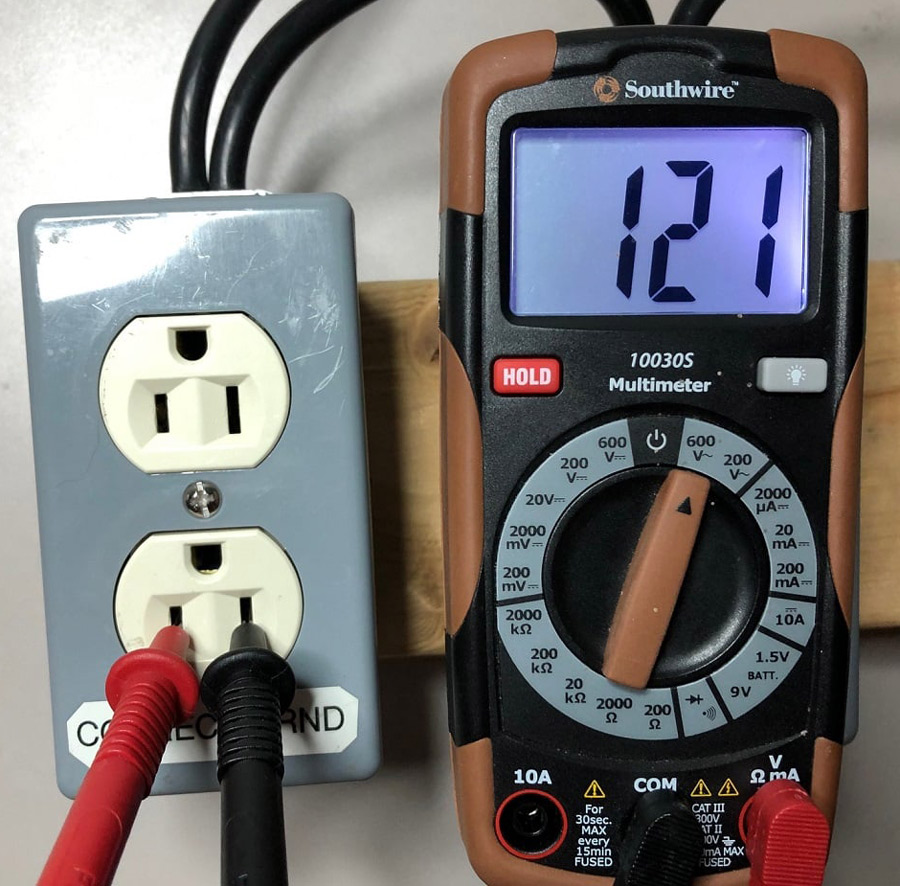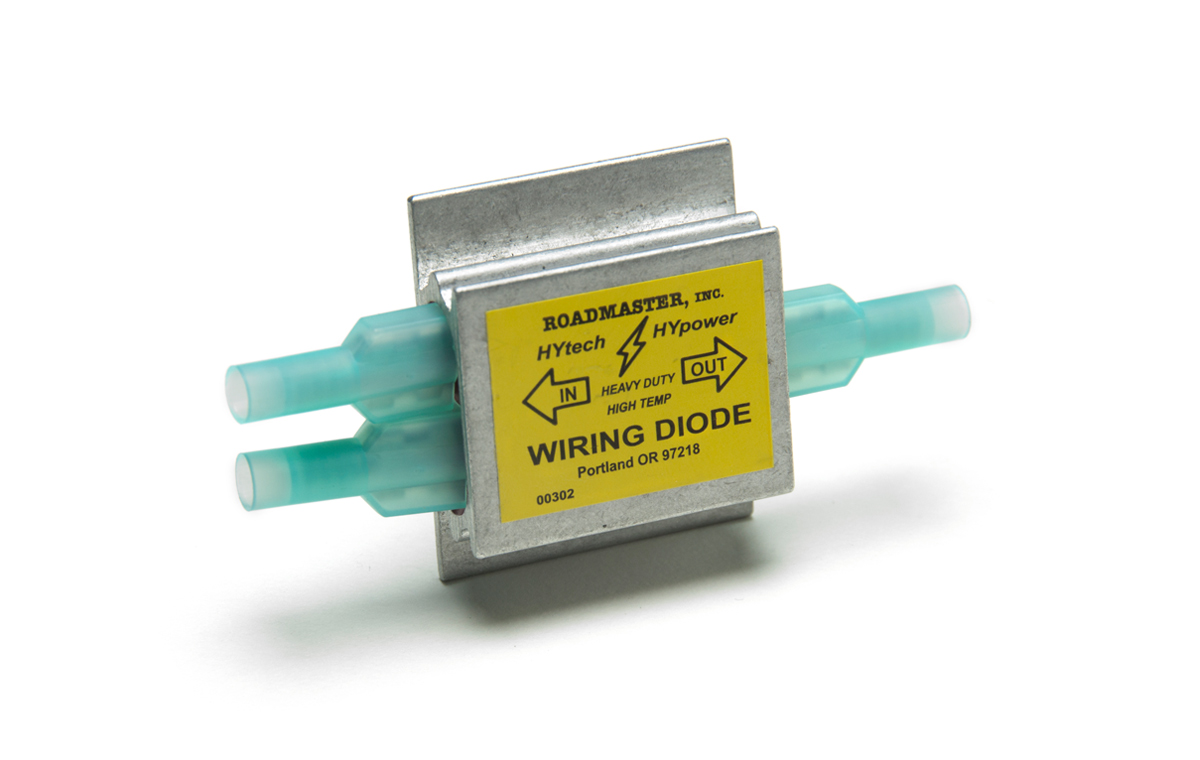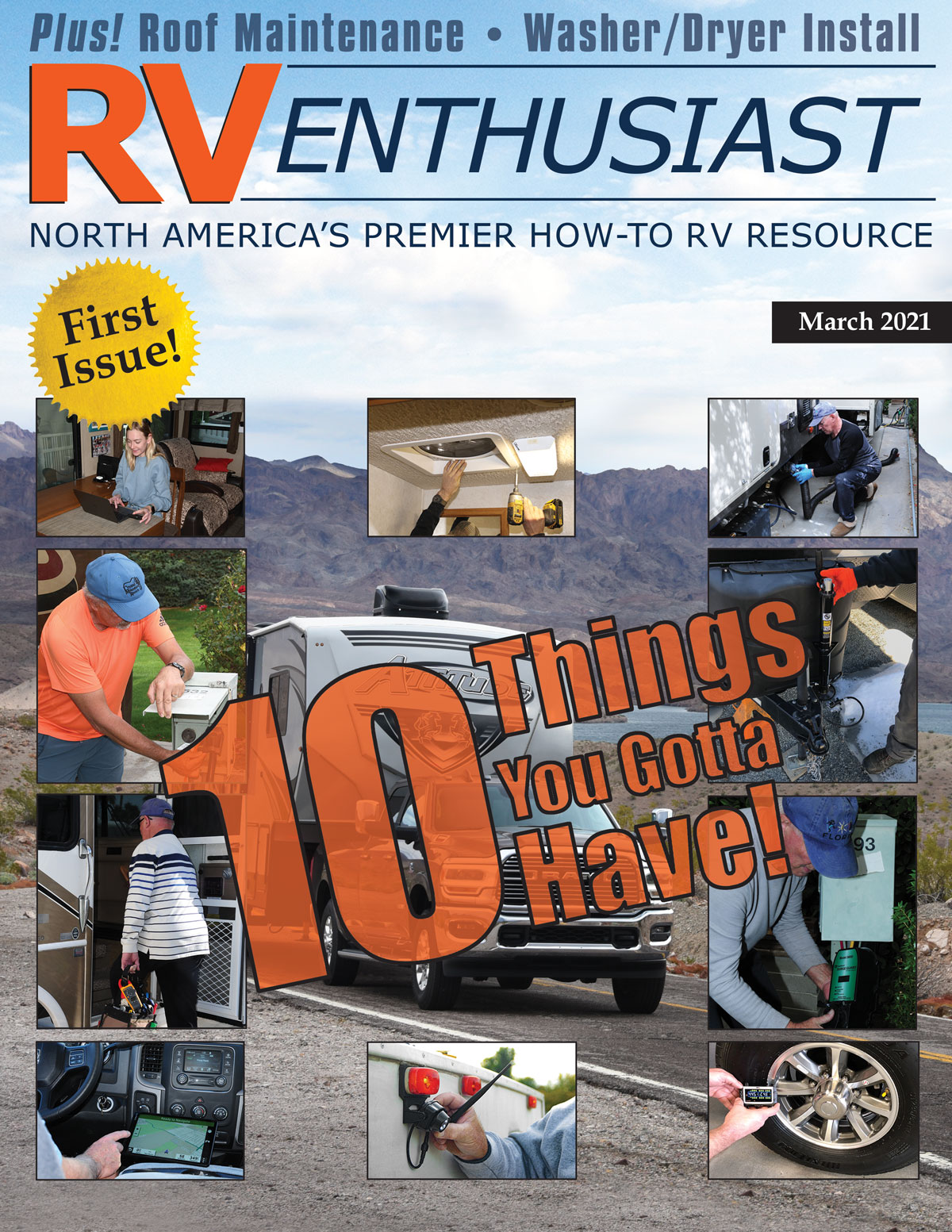Subscriber Access Only
Special Offer
Get 1 year of RV Enthusiast Magazine for just $9.99
Unlock My Offer No ThanksAlready a subscriber? Click here to access full issues.

How to clean, inspect, maintain and repair a ravaged RV roof, plus tips on preventative maintenance and replacement options. And while we were at it, we addressed door, window, skylight and corner leaks. Why? Because we thought you should know how to tackle just about everything related to water incursion in an RV.
Installing a stacking washer and dryer in a closet pre-prepped at the factory will take the sting out of keeping clothes clean and fresh during extended travels. It’s not an easy upgrade, but you will look and smell nicer for it.
Looking for adventure? Hit the road when everyone else is putting their RV into cold storage. The benefits? Unmatched scenery, solitude and outdoor activities. The drawback? It’s really cold, so you need to know how to prepare your RV for life in sub-freezing environments.
Welcome to the premier issue of the only magazine created by and for hands-on RV enthusiasts! Here’s your chance to meet the whole gang behind it.




A/C and a four-in-one microwave. Plus the latest new products across the industry.











(800) 830-9729 ext. 3
[email protected]
EDITOR Bruce Hampson
(574) 584-4616
[email protected]
TECHNICAL DIRECTOR
Chris Dougherty
(800) 830-9729 ext. 5
[email protected]
TECHNICAL EDITOR Chris Hemer
(800) 830-9729 ext. 6
[email protected]
SOCIAL MEDIA DIRECTOR Jim Mac
(800) 830-9729 ext. 7
[email protected]
ART DIRECTOR Eden Redmond
[email protected]
120 Atwater Road, Springfield, MA 01107
RV Enthusiast is published monthly by RVE Media Group Inc., 3425 East Golden Valley Road, Reno, NV 89506. RV Enthusiast magazine is copyrighted in the United States, Canada, Great Britain and other countries. All rights reserved. Permission to reprint or quote excerpts considered on an individual basis and granted only by written request. Advertising rates and Editorial calendars provided upon request.
North America’s premier “how-to” RV magazine!
hat you’re reading is, in the belief of those who produced it, quite an ambitious undertaking: a magazine created by — and for — hands-on RV enthusiasts. As such, I’m dedicating this space to provide a bit of the rationale behind RV Enthusiast — and to introduce you to the crew that made it happen.
Anytime you take what’s essentially a house on wheels and subject it to the continual jostling of on- and off-highway travel for hundreds (if not thousands) of miles, things are going to shake — and, sometimes, break. It’s not a question of “if” it will happen, but “when” — and what happens afterwards. Because while most people love their RVs, they don’t necessarily know how to fix, maintain or upgrade them to suit their particular needs. As a result, the service bays of most RV dealerships are often flooded with motorhomes, travel trailers and fifth-wheels in need of some attention.
At RV Enthusiast, we have a better idea.
Fix it yourself.

Both numbers were very nearly off the charts in 2020.
According to the RV Industry Association, a strong December pushed wholesale shipments to 430,412 for the year — the third-highest annual total on record.
And, while final registration numbers for the year weren’t available as this issue of RV Enthusiast went to production, 2020 was nonetheless shaping up as perhaps the best year ever recorded for new RV sales. According to Statistical Surveys Inc., a Grand Rapids, Mich.-based company that follows new RV registrations, there were 29,355 RVs registered in North America in November 2020, bringing retail registrations to 486,097 through the first 11 months of the year.
Ving isn’t an all-inclusive vacation: it takes effort and know-how to find the relaxation that so many seek with camping. Congratulations to the founders and staff of RV Enthusiast for embarking on a journey to help bring more education and technical articles to our community. It’s a bold move but one that is well-timed, with so many consumers trying RVing for the first time in the past year.
Like the founders of RV Enthusiast, I too have felt moved to help make better stories and tools available to RVers that put a little more “recreation” in recreational vehicles. I left my role at Airstream Inc. and helped create the Togo Group in 2018, which now operates Roadtrippers.com, RVillage.com and TogoRV.com. We’re making quick progress on our mission to bring out the joy of getting to, staying in, and exploring the outdoors. If you haven’t tried one of our products I hope that you will soon — and then share your feedback with me. Our RV GPS, automatic safety recall notifications and RV-specific checklists are some of my favorite stress-reducing features.
ob and Sharon Brighton have been avid RVers for several years, mostly escaping to state parks for long weekends during the summers in Michigan, where Bob is a cabinet maker and Sharon is a school principal.
But with Sharon set to retire this June and Bob planning to step back from most of his work, too, the couple intend to take longer RV trips in their 2019 Grand Design Reflection 303RLS, which is paired with a 2019 Ram 2500 diesel outfitted with B&W Companion Hitch for the truck-bed puck system.
One such planned trip, scheduled with several other RVing family members this fall, will be a long journey throughout New England including a stop at Acadia National Park in Maine.

e it motorhome, trailer or truck camper, an RV is comprised of many different parts. To the naked eye, nowhere is this more evident than the exterior. The roof, front and rear caps and the exterior walls — not to mention windows and vents — are all individual components on most units, carefully fitted and joined with rubber, caulks, and sealants. If all goes well, the RV in question should remain leak free for many years.
In the event of a defect or deferred maintenance, however, leaks can occur — and the worst part about that is, they may be too small to notice until it’s too late. Water creeping into the membrane on a rubber roof can cause dry rot to the wood underneath, while a constant drip into a wall can cause delamination. None of these problems are easy or cheap to fix, but the good news is, you can prevent them with a little maintenance and fix many small leaks yourself. We’ll outline the procedures to help guard your investment against the elements and, while we’re at it, present a few ways to seal leaky doors and windows from both water and drafts.

uying a new RV is oftentimes a balancing act between what you want and what you can afford. You walk onto a dealership lot and fall in love with a certain RV only to have your better half — or your conscience — let you know in no uncertain terms that it’s about six feet longer, 1,000 pounds heavier and $10,000 more expensive than what you’ve budgeted for.
Don’t worry, we’ve all been there. But while it may not be evident to newer RV enthusiasts, the quality and components seen in today’s crop of even entry-level RVs is actually pretty impressive. As you’ve probably already noticed, the RV industry tends to reflect trends in the housing market — and both have thankfully come a long way from the days of shag carpeting and metal mini-blinds. In today’s RVs, for example, it’s not unusual to see pop-up AC outlets with USB ports, LED lighting, Bluetooth entertainment systems and flatscreen TVs — even in entry-level units.
And it’s not just the cool stuff that should be on your “wish list.” Rearview cameras and tire-pressure-monitoring systems were relatively unknown to the RV market just a handful of years ago. As a consequence, there are legions of RVs traveling the highways without such “must have” safety equipment.
Fortunately, these accessories and more like them are readily available in the aftermarket and only require an hour or two for installation in most instances.
With that in mind, the staff of RV Enthusiast has identified 10 things every RVer needs to add to their new/used RV or tow vehicle that will make it easier, safer and more comfortable to hit the road this spring. Some are as simple as ensuring you have the right assortment of electrical adapters on hand, while others — from adding a power roof vent or a cell signal booster — will add to your comfort throughout the trip.
One thing’s for sure: once you upgrade to these and other accessories highlighted on the following pages, you’ll wonder how you ever managed to go camping without them.


taying connected has never been more important. Smartphones, tablets and laptops have become an integral part of our daily lives — so much so that, when something goes awry, many RV owners have to reach for their anti-depressants. We’re just plain obsessed with watching the bars on our devices showing reception strength — and when nothing or just one appears, we tend to shudder. Shockingly, given all the advancements in technology, the number of service providers and, of course, the staggering number of customers, not all places have cell towers within range. Consequently, we cuss at our devices, go running up hills or to clear areas to find better signals or, in many cases, just give up the ghost.
In a world where someone builds something and someone else builds something to make it work better, Wilson Electronics’ weBoost can provide a welcome respite for RVers who need to stay connected, whether for professional or social reasons. The weBoost name has pretty much become synonymous with cell boosting equipment, and its new Drive Reach RV cell booster is one product in the company’s lineup that is a “must have” for RV travelers, especially those who stray from large urban areas.



hile many of us have been plugging into shore power for decades without any kind of shore power protection, doing so simply isn’t a good idea — especially today. Campgrounds are often full to capacity with RVs that require up to 10 times the electrical power of their predecessors from even 10 years ago. An overloaded RV park’s power grid can create all kinds of electrical system failures, ranging from low voltage to high voltage, voltage spikes and lost safety grounds. Some of these electrical problems can damage your expensive RV components such as air conditioners, microwave ovens and refrigerators. Worse yet, other RV park (and home) power failures can create potentially dangerous conditions such as electrical shock and fires caused by electrical overload.



hen it comes to improving vehicle safety, few products have been met with more enthusiasm by drivers than rearview cameras. Also known as backup cameras, these systems tie into a dash display or smart device and provide an extra layer of assurance that a vehicle operator didn’t overlook something before shifting into reverse — or, worse yet, that a person or animal hasn’t inadvertently entered the blind area behind the vehicle.
In fact, rearview-monitoring technology — meaning, essentially, rearview cameras — has been mandated by federal regulations since May 2018 for all new cars, trucks and vans weighing less than 10,000 pounds sold in the U.S.
Unfortunately, rearview camera systems haven’t yet been required equipment for RVs. It stands to reason, however, that if such a system will aid a driver when backing up a 16-foot-long Toyota Corolla, it would prove invaluable when reversing direction in a Ford F-150 pickup towing a 30-foot-long travel trailer. How many times have you had to ask a traveling companion to stand at the rear of your trailer or motorhome and guide you into a campsite?



etting outdoors and “roughing it” in an RV means different things to different people. Some go all-out and load up the RV for a weekend or more of off-the-grid camping. Others, however, will opt to leave their hectic lifestyle for a few days and find the nearest campground or RV resort that allows them to plug into enough power to enjoy life’s comforts while still shedding the everyday stress that tends to walk in our shadows.





onnecting or disconnecting a travel trailer or utility trailer to a tow vehicle with a manual crank jack can be a slow, tedious process. Sure, you can simply accept it as the price of camping — and even include it as part of your cardio-vascular exercises while on the road. If you’d rather take a pass on revving up your rotator cuff muscles, however, an electric tongue or A-frame jack can reduce this to the push of a button.
That said, not everyone wants to invest the money in a power jack or be reliant on enough battery power to operate it. Indeed, many utility trailers don’t even have a battery to run it.



magine you’re laying on the bed in your RV at a beautiful coastal campground. The window by your bed is open, and you can hear the ocean in the distance as a nice breeze flows over your body. Or perhaps you’re camped in the desert, where your RV sizzles under a relentless sun. Wouldn’t it be nice to be able to draw in more fresh air, or push stale, humid air out? You can. This is known as ventilation control — it’s the “V” in “HVAC” (Heating, Ventilation and Air Conditioning). When it comes to keeping RVing enjoyable, or for that matter, tolerable at any time of year, good ventilation is key.
Good RV ventilation occurs when fresh air is directed or drawn inward through one opening and allowed to exit via another. This can be achieved via one of two basic methods: natural and forced.


ost of us don’t give a lot of thought to our tires. Other than periodically checking them for the correct inflation pressure and giving them a quick scrub when washing our vehicles, tires are basically taken for granted. So long as they have adequate tread and aren’t outside the recognized aging window — Michelin, for example, allows for 10 years if the RV has been stored indoors but requires an annual inspection after five years, while other manufacturer’s recommendations may vary — they are just expected to perform.
When they don’t, however, all sorts of things can happen — none of them good.
“Air carries the load,” said Thomas “Bear” Musgrave, vice president of Pressure Systems International (PSI) and business unit director for Truck System Technologies (TST). “If there’s a problem and the driver isn’t aware of it, it can be catastrophic.”


ost of us work hard, so it’s not surprising that we all probably put forth an effort to save money, as well — or, at least, not spend it foolishly. That might translate into using generic paper towels, looking around for the best price on truck fuel and comparing prices for online purchases. It’s simply smart shopping. One place you absolutely shouldn’t cut back on, however, are essential RV accessories like power connectors, water and sewer hoses and assorted adapters.
RV parts and accessories can, for the most part, be separated into three categories: fluff, nice to have and essential. That latter list is the most important: “Essential” items should include everything you need to connect your RV to utilities at a fixed-base operation, such as a campground, Flying J or home. The utilities are what make your RV what it is and failure to have what you need — or to have them fail at the wrong time — can be a trip-ending affair.
Sewage Handling
If you’ve ever been exposed to RV sewage, you know it’s not very pleasant. A cheap hose can fail in mid-dump, creating a ruinous fountain of excrement that you are unlikely to forget anytime soon.



et’s face it: The co-pilot always gets the brunt of any argument stemming from getting lost. It usually begins with something like, “Can’t you read a map? I’m driving, so I can’t be the only one figuring out where to go. Now I’ll never get this thing turned around,” or words to that effect.
Fortunately, the Global Positioning System (GPS), a gift from the military, has changed the way we navigate, taking most of the stress out of traveling unknown routes. Now we talk to an electronic co-pilot who, frankly, doesn’t take any guff from the driver. Not that many years ago, talking to a device would qualify one for a sanity check — but times have changed. Now it’s hard to imagine life without a familiar robotic voice telling you which way to turn.
Garmin is a world leader in the GPS navigational space and has been marketing portable devices for a long time, gradually adding features that have become popular with RV owners. Its latest offering, the RV 1090, raises the bar when it comes to screen size, design and performance. It also boasts enhanced RV park listings and the ability to input personal profiles to make routing safe for large and tall vehicles.


ne of the challenges of being on the road with your RV is how to perform the occasional repair or troubleshooting when you may be hundreds or even thousands of miles away from home. You’re not about to take along your eight-drawer tool chest to ensure you can address any situation — but with some forethought you can assemble an easily stowable tool tote filled with enough of the right tools to get you out of most jams.
Here’s a look at a list of the tools and meters that, through trial and error and a lot of miles, I learned to take with me on the road. Many of them have saved my bacon — more than once.
3-Meter Kit
When an electrical failure occurs it’s possible to lose your lights, refrigeration, climate control — even the ability to pull your slides back in so you can break camp and move. I highly recommend that every RVer carry a basic 3-piece meter kit. This $30-$40 investment will let you accurately measure your RV battery’s charge level, find a blown fuse in your slide motors, determine if the outlet you’re plugging into has proper voltage, polarity and grounding and even do a quick check to confirm that your RV is properly grounded and doesn’t have a hot-skin condition (see “The Shocking Truth” elsewhere in this section).

raveling in an RV gives one a sense of freedom to explore and the ability to leave the hubbub of daily routines. While it would be nice to chuck all responsibilities and chores, reality suggests that one of our regular routines — washing clothes — follows us like a lovesick puppy. The majority of owners likely rely on laundry facilities in RV parks and local communities. While making use of a laundromat has its social benefits, there is a lot to dislike when using public facilities, from dirty or broken equipment to long wait times for available washers/dryers. Having your own washer and dryer inside the RV adds “loads” of convenience to any trip, and if the trailer, fifth-wheel or motorhome has been prepped for such equipment, Splendide has a stacker washer/dryer set-up that will bring smiles to whoever is responsible for keeping clothes clean.


A washer and dryer (or combination unit) are typically offered as a factory option in many larger RVs, and even more models offer “washer/dryer prep,” with all of the necessary plumbing and electrical connections already in place. While it may be tempting to modify an existing RV without washer/dryer prep, such a project is not recommended without tons of experience, the stomach to tear things apart and monumental patience. In most cases, it simply cannot be done — but if the RV is factory prepped for a washer and dryer, the project is achievable for those with a decent mechanical aptitude.
inter travel opens up so many new and adventurous opportunities that, at one time, were mostly avoided by RV enthusiasts. Conventional wisdom relegated RV travel to only three seasons, with winter reserved for hearty souls who didn’t mind struggling with nature to stay warm. Times have changed, and RVs are more capable than ever of taking on cold-weather challenges — but they’re not perfect. Proactive winter RVers can protect vulnerable systems and accessorize to make journeys to their favorite winter destinations not only possible, but downright comfortable.
As snowmobile and cross-country skiing/snowshoeing fanatics (somewhat of an anomaly for Southern California residents), traveling to snow country was an annual rite of passage for my family. Early trips were interesting, sans many of the modern technological advancements and accoutrements to keep us warm. Portable generators were not that portable and solar systems were way out of our budget back in the 1970s when we first started traveling to snow country, so we relied on batteries and some “Rube Goldberg ingenuity.” We were early adopters of 6-volt golf-cart batteries; to keep them charged in the field, we ran the tow vehicle at a high idle using a rock to hold the accelerator in place. Crude, but it worked.
hile their names aren’t emblazoned on the outside of travel trailers, fifth-wheels or motorhomes — and, as a consequence, are mostly unknown to RV owners — component suppliers are the lifeblood of the RV industry. They also tend to be one of the drivers of new technology cropping up regularly inside and outside new RVs that are helping to transform the camping lifestyle.
One such supplier, Elkhart, Ind.-based WAY, recently introduced a number of new kitchen appliances — as well as a new air-conditioning unit — to the industry. And, according to WAY CEO Wayne Kaylor, all will become available to the aftermarket — meaning do-it-yourselfers will soon be able to upgrade their existing components.
The new products include an expanding line of griddles, smaller slide-in stoves, a unique microwave with a pull-out drawer and what Kaylor describes as the largest 12-volt DC refrigerator to date, a 17-cubic-foot, three-door model.

General Motor’s MultiPro and Multi-Flex tailgates can perform a lot of useful functions — but if the inner tailgate is released and allowed to swing down while there’s a hitch in the receiver, costly damage could be the result. The CURT protective MultiPro/Multi-Flex tailgate sensor is the solution. The sensor is integrated with a standard hitch cap and disables the inner tailgate functionality when any shank is installed in the receiver. It is available in standard 2-inch and 2-1/2-inch receiver options and can be installed easily with no splicing required, according to the company. Curt Manufacturing;
www.curtmfg.com.

Diodes are frequently used in wiring kits to prevent the backflow of current to the electrical system of the towed vehicle (dinghy) or motorhome. However, some newer vehicles now use a multiplex wiring system, whereby multiple electrical signals may be sent down a single wire (brake and taillights, for example). If an ordinary diode is used in these applications, it can result in several light circuits activating instead of only the one desired. To solve this problem, Roadmaster recently released its new Smart Diode, which correctly modulates the voltage to activate only the intended circuit. Smart Diode kits are available for applications with incandescent bulbs (part #782) or LED lighting (#789). Roadmaster, Inc.;
roadmasterinc.com.

A power A-frame jack (aka tongue jack) is a great addition to any RV, but the new Power Stance jack from Lippert changes the game with an industry-first 2-way- to 7-way plug powering system. By connecting the Power Swap Auxiliary Cord, the user can easily plug the jack into the tow vehicle’s 7-way receptacle without draining the RV batteries or using a hand crank. Other features include four LED lights make to make it easy to see what you’re doing, a chain storage ring to prevent chains from dragging on the ground and a storage compartment for the Power Swap cable cord. Lippert;
store.lci1.com
hether you are traveling with your RV for a short one or two-day trip or are a full-timer whose RV is your home, you still have to decide where to go. Perhaps you enjoy traveling to well-known places such as America’s national parks, but for those looking to discover small, remote places, keep reading — I’ve spent most of my travels tracking down interesting destinations, many times off the beaten path. Along the way, I’ve also developed — and will share — alternative ways to find scenic and historical locations while also providing a backdrop for watching wildlife.
I like to explore remote settings and capture these memories through photography. The old expression, “a picture is worth a thousand words,” could not be truer when it comes to learning about a location and remembering details often not described in words. I enjoy taking pictures of animals and nature, and I do a great deal of research and planning to find the proper location and time of year to get the best results. When someone is admiring one of my nature photographs, I often get asked the questions, “How did you get that shot?” or “How did you find that place?” Here’s how I do it.


























